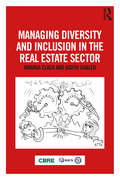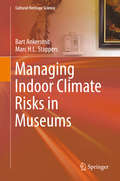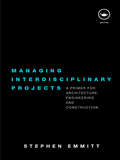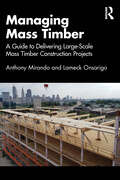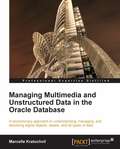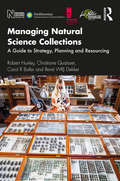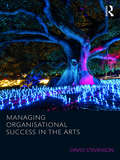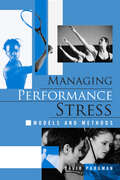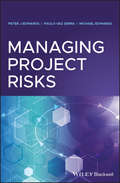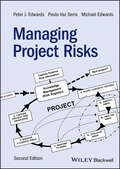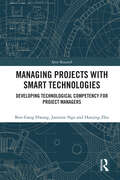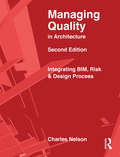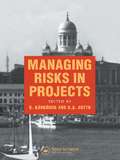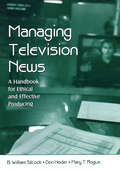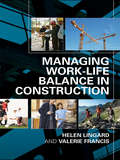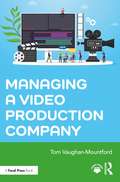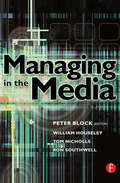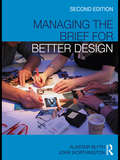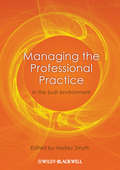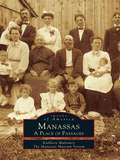- Table View
- List View
Managing Diversity and Inclusion in the Real Estate Sector
by Amanda Clack Judith GablerResearch shows that high-performing organisations focus on diversity and inclusion (D&I). In any workplace, it is important to both understand and recognise the benefits that having a D&I workforce provides. It is integral to developing people within an organisation, serving clients as best we can, and playing an important leadership role in communities. This book is the first to place D&I at the centre of successful real estate and construction organisations. It provides guidance to, and most importantly, actions for professionals in the sector who want to make D&I an inherent part of the culture of their organisation. This book has been written to bring the sector up to speed with what D&I is all about and how a D&I strategy can be implemented to secure future success. It presents a practical and easy-to-read guide that can help organisations and their leaders engage with and apply this agenda to win the war for talent in real estate and construction. This book is essential reading for all property leaders and professionals working in the real estate and construction sectors. Readers will gain especially from personal reflections on all aspects of diversity by a broad range of people working in the property industry.
Managing Growth in America's Communities: Second Edition
by Douglas R. PorterCommunities across the country are turning to the concept of "growth management" to help plan for the future, as they seek to control the location, impact, character and timing of development in order to balance environmental and economic needs and concerns. Managing Growth in America's Communities presents practical information about proven strategies, programs and techniques of growth management for urban and rural communities. Topics examined include: public roles in community development determining locations and character of future development protecting environmental and natural resources managing infrastructure development preserving community character and quality achieving economic and social goals property rights concerns The author describes regulatory and programmatic techniques that have been most useful, obstacles to be overcome, and specific strategies that have been instrumental in achieving successful growth management programs. He provides examples from dozens of communities across the country as well as state and regional approaches currently in use. Brief profiles present overviews of problems addressed, techniques implemented, outcomes, and contact information for conducting further research. Among the communities profiled are Arlington County, Virginia; Fort Collins, Colorado; Lexington-Fayette County, Kentucky; Lincoln, Nebraska; Sarasota, Florida; Raleigh, North Carolina; Scottsdale, Arizona; and numerous others. Also included in the volume are informational sidebars written by leading experts in growth management including Robert Yaro, John De Grove, David Brower, and others.Managing Growth in America's Communities is essential reading for community development specialists including government officials, planners, environmentalists, designers, developers, business people, and concerned citizens seeking innovative and feasible ways to manage growth.
Managing Growth in America's Communities: Second Edition
by Douglas R. PorterIn this thoroughly revised edition of Managing Growth in America's Communities, readers will learn the principles that guide intelligent planning for communities of any size, grasp the major issues in successfully managing growth, and discover what has actually worked in practice (and where and why). This clearly written book details how American communities have grappled with the challenges of planning for growth and the ways in which they are adapting new ideas about urban design, green building, and conservation. It describes the policies and programs they have implemented, and includes examples from towns and cities throughout the U.S.Growth management is essential today, as communities seek to control the location, impact, character, and timing of development in order to balance environmental and economic needs and concerns.The author, who is one of the nation's leading authorities on managing community growth, provides examples from dozens of communities across the country, as well as state and regional approaches. Brief profiles present overviews of specific problems addressed, techniques utilized, results achieved, and contact information for further research. Informative sidebars offer additional perspectives from experts in growth management, including Robert Lang, Arthur C. Nelson, Erik Meyers, and others.In particular, he considers issues of population growth, eminent domain, and the importance of design, especially green design. He also reports on the latest ideas in sustainable development, smart growth, neighborhood design, transit-oriented development, and green infrastructure planning. Like its predecessor, the second edition of Managing Growth in America's Communities is essential reading for anyone who is interested in how communities can grow intelligently.
Managing Indoor Climate Risks in Museums
by Bart Ankersmit Marc H.L. StappersThis book elaborates on different aspects of the decision making process concerning the management of climate risk in museums and historic houses. The goal of this publication is to assist collection managers and caretakers by providing information that will allow responsible decisions about the museum indoor climate to be made. The focus is not only on the outcome, but also on the equally important process that leads to that outcome. The different steps contribute significantly to the understanding of the needs of movable and immovable heritage. The decision making process to determine the requirements for the museum indoor climate includes nine steps: Step 1. The process to make a balanced decision starts by clarifying the decision context and evaluating what is important to the decision maker by developing clear objectives. In Step 2 the value of all heritage assets that are affected by the decision are evaluated and the significance of the building and the movable collection is made explicit. Step 3. The climate risks to the moveable collection are assessed. Step 4: Those parts of the building that are considered valuable and susceptible to certain climate conditions are identified. Step 5. The human comfort needs for visitors and staff are expressed. Step 6: To understand the indoor climate, the building physics are explored. Step 7. The climate specifications derived from step 3 to 5 are weighed and for each climate zone the optimal climate conditions are specified. Step 8: Within the value framework established in Step 1, the options to optimize the indoor climate are considered and selected. Step 9: All options to reduce the climate collection risks are evaluated by the objectives established in Step 1.
Managing Interdisciplinary Projects: A Primer for Architecture, Engineering and Construction
by Stephen EmmittConstruction, architecture and engineering projects are complex undertakings, involving a temporary grouping of people and companies, with different agendas and experience, coming together to achieve a project goal. This book investigates the dynamics of the relationships between individuals involved in architecture, engineering and construction projects. It combines a structured theoretical framework, derived from social psychology and mainstream management theory, with case studies and research from the built environment sector. Focusing on how people interact, communicate and work together, it examines how best to manage the interdisciplinary relationships that form and reform during the project life cycle. The book covers vital areas of project management, whose importance has recently come to be recognized, and will be valuable for students at both undergraduate and graduate level. Practitioners will also find it a useful insight into the social aspect of project management, with implications and applications that apply to all projects in the built environment sector.
Managing Mass Timber: A Guide to Delivering Large-Scale Mass Timber Construction Projects
by Anthony M Mirando Lameck OnsarigoManaging Mass Timber: A Guide to Delivering Large-Scale Mass Timber Construction Projects equips both practitioners and students with in-depth operational knowledge essential for constructing large-scale mass timber (MT) structures.As mass timber construction continues to grow at an unprecedented pace, this textbook provides readers with the foundational knowledge required to successfully deliver MT construction projects. Grounded in widely taught theoretical frameworks from construction project management, the book focuses on the operational aspects of mass timber within the context of the five core pillars of construction management: Safety, Quality, Cost, Schedule, and Sustainability.This text also explores the historical development of mass timber, supply chain logistics, risk management, relevant codes and standards, and other key operational aspects. It integrates core principles of project management and lean manufacturing, which are fundamental both in academic settings and professional practice. To support both students and instructors, the book includes chapter summaries, test questions, and real-world case studies.This is the first textbook designed specifically to prepare readers in architecture, engineering and construction management (AEC), and related fields to effectively understand and manage the mass timber construction process in the field.
Managing Multimedia and Unstructured Data in the Oracle Database
by Marcelle KratochvilThis book is written in simple, easy to understand format with lots of screenshots and step-by-step explanations. If you are an Oracle database administrator, Museum curator, IT manager, Developer, Photographer, Intelligence team member, Warehouse or Software Architect then this book is for you. It covers the basics and then moves to advanced concepts. This will challenge and increase your knowledge enabling all those who read it to gain a greater understanding of multimedia and how all unstructured data is managed.
Managing Natural Science Collections: A Guide to Strategy, Planning and Resourcing
by Robert Huxley Christiane Quaisser Carol R Butler René WRJ DekkerManaging Natural Science Collections demonstrates the need for consistency and evidence-based decision making in the management of natural science collections, which are becoming increasingly valuable when it comes to addressing societal challenges. Drawing upon the experience of four experts who have managed some of the largest and most diverse collections in the world, the book aims to assist in the making of strategic and operational decisions regarding care, development, access and resource management. Encouraging the reader to consider how collection strategies can be aligned with the mission of their institution and contribute to its vision, the authors also examine ways to deliver a consistent approach that will secure the present and future availability and relevance of collections. Principles of good practice and resource optimisation in an ethical and legal context are provided throughout the book, as well as case studies, sample documents and templates, all of which will be useful for discussion and teaching. Managing Natural Science Collections encourages each reader to consider the different options available to them. As such, it should be essential reading for museum practitioners and other professionals around the world who are involved with any strategic aspect of managing natural science collections. Students of museum studies will also find much to interest them within the pages of this book.
Managing Organisational Success in the Arts (Routledge Research in Creative and Cultural Industries Management)
by David StevensonThe creative and cultural industries are a dynamic and rapidly expanding field of enterprise. Yet all too often the dominant narrative about arts organisations is one of crisis, collapse, and closure. This edited collection seeks to challenge that narrative through pursuing a focus on organisational success in the management of creative and cultural organisations. This book offers a robust and in-depth analysis of nine international case studies exploring how different organisations have achieved their objectives through effectively managing their resources. Spanning a broad cross section of the cultural sector including Theatres; Multi-Arts Venues; Performing Arts Companies; Museums and Galleries; and Festivals and Events, these cases highlight the importance of examining an individual organisation’s success in relation to its environmental context, revealing not only how arts organisations work in practice, but also providing inspiration and encouragement for those wishing to emulate such success. With an explicit focus on examining theory in practice, this unique collection will be of great interest to students, academics, and practitioners alike. While traditional approaches have often been overly theoretical, this pragmatic approach will help students to gain a richer understanding of how to manage cultural and creative organisations more effectively.
Managing Performance Stress: Models and Methods
by David PargmanOver the past 16 years, new theories and models have emerged in the stress and anxiety knowledge base regarding the unique forms associated with performance. Existing theories have been applied in creative and helpful ways to better explicate relationships between stress and anxiety with performance. Recently, more sophisticated statistical strategies have been applied to data collected with performers, and additional, safe and expedient strategies for managing stress and anxiety have surfaced. Despite these new advances, the field has been lacking an up-to-date and practical text for undergraduate and graduate students in performing or performance-mentoring programs. Managing Performance Stress examines psychological and psychophysiological models and theories that explain causes of anxiety and stress. An easy-to-use reference work for athletes, musicians, dancers and actors as well as those who devise and conduct their training programs, the book presents exercises, coaching devices, and strategies for conquering stress and anxiety. It is an invaluable resource for those who are performers, will be performers, or who are preparing to mentor, coach or teach performers. The principles enunciated in Managing Performance Stress apply equally to the musician holding an oboe and the athlete holding a baseball bat. The issues explored and the theories, principles, models, hypotheses discussed all bear upon and clarify arousal, stress and anxiety related to artistic and sport performance, irrespective of its kind.
Managing Project Risks
by Michael Edwards Peter J. Edwards Paulo Vaz SerraA comprehensive overview of project risk management, providing guidance on implementing and improving project risk management systems in organizations This book provides a comprehensive overview of project risk management. Besides offering an easy-to-follow, yet systematic approach to project risk management, it also introduces topics which have an important bearing on how risks are managed but which are generally not found in other books, including risk knowledge management, cultural risk-shaping, project complexity, political risks, and strategic risk management. Many new concepts about risk management are introduced. Diagrams and tables, together with project examples and case studies, illustrate the authors’ precepts and ideas. Each chapter in Managing Project Risks begins with an introduction to its topic and ends with a summary. The book starts by providing an understanding and overview of risk and continues with coverage of projects and project stakeholders. Ensuing chapters look at project risk management processes, contexts and risk drivers, identification, assessment and evaluation, response and treatment options, and risk monitoring and control. One chapter focuses entirely on risk knowledge management. Others explore the cultural shaping of risk, political risk in projects, computer applications, and more. The book finishes by examining the current state and potential future of project risk management. In essence, this book: Effectively communicates a conceptual and philosophical understanding of risk Establishes the nature of projects and the stakeholders involved in them Presents a systematic and logically progressive approach to the processes of project risk management Demonstrates how to recognize the drivers of project risks and the factors which shape them Emphasizes the importance of capturing and exploiting project risk knowledge Provides guidance about implementing and building (or improving) project risk management systems in organizations Managing Project Risks will benefit practitioners and students of project management across a wide range of industries and professions.
Managing Project Risks
by Michael Edwards Peter J. Edwards Paulo Vaz SerraA comprehensive and highly practical overview of project risk management emphasising pragmatic solutions and user-friendly methods without advanced mathematical techniques Managing Project Risks provides a comprehensive treatment of project risk management, offering a systematic but easy-to-follow approach. This book explores critical topics that influence how risks are managed, but which are rarely found in other books, including risk knowledge management, cultural risk-shaping, project complexity, political risks, and strategic risk management. The book commences with foundational concepts, providing an overview of risk, project definitions, project stakeholders, and risk management systems. Subsequent chapters explore the core processes of project risk management, including risk identification, analysis, evaluation, response strategies, and risk monitoring and control. Additional topics include risk knowledge management, the influence of culture on risk, political risks in projects, and relevant software applications. Experienced readers may choose to navigate directly to the later chapters, which focus on strategic risk management and offer recommendations for planning, building, and maturing a project risk management system. Throughout, the authors impart a practical approach that does not rely on high level expertise or advanced mathematical techniques; the emphasis remains on pragmatic solutions, user-friendly techniques, and reliable communication, enabling readers to seamlessly integrate theory into practice. Updates to the newly revised Second Edition of Managing Project Risks include: Additional tools and techniques for risk identification and an expanded treatment of risk communication A new tool for early-stage project complexity assessment—the stage where uncertainties, and thus threat and opportunity risks, are at their highest level A more substantial treatment of planning for crisis response and disaster recovery, taking into consideration climate change and the increasingly prevalent impacts of severe weather phenomena More information on strategic risk management, now including public and organizational policy development with respect to risks in projects Managing Project Risks is an essential resource for practitioners of project management across architecture, construction, engineering, and technology disciplines, for undergraduate and postgraduate students, and for public and private sector stakeholders involved in decision-making and policy development. It is useful wherever project-driven activities are undertaken.
Managing Projects with Smart Technologies: Developing Technological Competency for Project Managers (ISSN)
by Bon-Gang Hwang Jasmine Ngo Hanjing ZhuWith a focus on project managers (PMs) in the construction industry, this book addresses the impact of smart technology applications on project management and examines how technologically competent PMs can be developed for successfully managing and delivering projects with smart technologies.The book assesses the changes to the knowledge and skillsets required to manage projects with smart technologies; develops a Technological Competency Framework to improve PM competency when managing projects with smart technologies; and develops a Knowledge-Based Technological Competency Analytics and Innovations System to assess and improve the technological competency of PMs and provide recommendations to improve their competency.Managing Projects with Smart Technologies is ideal for PMs and academics in the areas of construction project management, engineering, architecture, and infrastructure and anyone involved in the technical training of professionals in these areas.
Managing Quality in Architecture: Integrating BIM, Risk and Design Process
by Charles NelsonCompletely revised throughout for this second edition, Managing Quality in Architecture addresses the new ISO 9001 standards after the significant 2015 revision. ISO 9001 is the global standard for quality, and firms certified under the 2008 edition have three years to upgrade their quality systems to the new Standard. This book helps architects, engineers and other designers working in the built environment to develop appropriate quality systems that meet the requirements of the international Standard. Importantly, the 2015 Standard integrates risk management with quality, something that earlier versions did not. Risk is an extremely important factor in professional design practice, and this important element is fully explored in the new edition. Similarly, the role of BIM in quality management is addressed as an integral part of practice. International contributions from the USA and Australia provide expertise in each topic, and case studies from the USA, Japan, Australia, New Zealand and the United Nations Office of Project Services provide easy-to-follow illustrations of the important areas to understand. The focus is completely practical, rather than theoretical, affording readers a concise picture of how the issues of excellence and quality performance flow across every aspect of design practice.
Managing Risks in Projects
by K.A. Artto K. KahkonenManaging Risks in Projects presents the latest skills, techniques, knowledge and experience of managing risks in projects from the leading worldwide experts. Many different types of projects are addressed spanning development, software, re-engineering, engineering and construction.
Managing Television News: A Handbook for Ethical and Effective Producing (Routledge Communication Series)
by B. William Silcock Don Heider Mary T. RogusManaging Television News provides a practical introduction to the television news producer, one of the most significant and influential roles in a newscast. Recognizing the need for formal training in this key role, authors B. William Silcock, Don Heider, and Mary T. Rogus have combined their expertise and experience to shape this essential resource on the responsibilities, demands, and rewards of the news producer position. Their book provides a strategic approach to producing newscasts and serves as an in-depth guide to creating quality, audience-friendly newscasts working within the realistic limitations of most newsrooms. It helps the student and the professional producer sort through the various deadline-driven challenges of creating a 30-minute newscast. Filled with real-world examples and advice from news directors, producers, and anchors currently in the business, and photographs illustrating the varied perspectives in the position, Managing Television News provides critical skill sets to help resolve ethical dilemmas, as well as keen and fresh insights on how to win the ratings without compromising news quality. Career concerns are also addressed. This resource is a pioneering book for the professional television newsroom and the individual reader interested in starting or expanding a producing career. It is an excellent text for the college classroom, as its structure fits neatly into a semester schedule, and it is a must-have resource for both seasoned and novice producers, as well as students in broadcast news.
Managing Urban Futures: Sustainability and Urban Growth in Developing Countries
by Martina Koll-Schretzenmayr Marco Keiner Willy A. SchmidUrbanization is one of the most powerful forces influencing global sustainability. It is dominated by three factors: population growth, rural-urban migration and subsequent urban expansion. Perhaps nowhere are these factors more dominant than in developing countries. This volume brings together leading experts including Alan Gilbert, John Friedmann, Saskia Sassen and Janice Perlman to explore the conflicting challenges of rapid urbanization in developing countries. While all have to contend with key issues such as social segregation, poverty, and loss of governability, the ongoing forces of urban growth vary from country to country. By comparing the challenges of urbanization in Africa, Latin America, Asia and the Pacific, this book puts forward a new way of thinking about mega- and million-cities in developing countries - one that promotes their vital function in society as engines of ideas, technologies, societal change, democratic transformation and loci of political will to build a new regime of global sustainability.
Managing Work-Life Balance in Construction
by Helen Lingard Valerie FrancisWork in the construction industry is particularly tough. It demands excessively long hours and frequent weekend work. Other characteristics are particularly marked, such as re-location, job insecurity and distinctive behavioural patterns, which negatively affect employees’ personal lives further. Work–life balance has emerged as one of the most pressing management issues in the 21st century. For construction managers dealing with traditional models of work and rigid work schedules, the issue may be especially difficult to manage, and yet the work–life balance is now recognised as an issue of strategic importance to the construction industry. It is critical to the construction industry’s continued ability to attract and retain a talented workforce, and it is also inextricably linked to organizational effectiveness and employees’ well-being. This book presents the argument for the management of work–life balance in the construction industry. It maps the changes to the workforce demographic profile and the changing expectations relating to work and personal life that occurred during the second half of the 20th century. Legal imperatives for managing work–life balance are set out. It also presents work–life balance theory and discusses the practical implications of research, along with extensive empirical data collected from the industry. Lastly, practical advice is provided about what construction organizations can and should do to manage work–life balance. This provides a unique guide to a key issue.
Managing World Heritage Sites
by Alan Fyall Anna LeaskWorld Heritage Sites are some of the most recognised locations around the world. They include natural sites such as the Grand Canyon and the Great Barrier and cultural ones such as the Pyramids at Giza, the Walled City of Baku in Azerbaijan and the Historic Centre of Riga in Latvia. The responsibility to manage them successfully and ensure that the resources are not damaged by visitors, war or environment is therefore vital. Managing World Heritage Sites covers the management issues encountered at cultural and natural UNESCO World Heritage Sites). WHS sites are high profile and as their designation states they are unique. They are often government owned and subject to political debate, they have iconic status and are therefore crucial to national tourism industries, and often involve a large number of stakeholders within their management structures. This text considers all of these aspects in arriving at solutions for site management principles. In 12 chapters and 5 case studies it covers issues such as WHS designation, marketing, visitor management, revenue generation and management. Each chapter will examine the management issues associated with managing heritage within the WH Sites, making clear use of management practices to apply the theory. Managing World Heritage Sites: • Includes international case studies such as World Heritage Sites in the Americas, Machupicchu, Stonehenge, Central Eastern Rainforest Reserves of Australia, Megalithic Temples of Malta.• Is authored by an international contributor team of well known and respected experts in this field • Has a user friendly and logical structure including aims, introduction, case study, conclusion, references and websites and examples best practice. • 5 specific case study chapters including a location map, an explanation of key issues, conclusion, and questions for self-study
Managing a Video Production Company
by Tom Vaughan-MountfordProviding a detailed break-down of the skills required to establish and grow a profitable production company, this book enables content creators and filmmakers to navigate the commercial video production world and the needs of its clients. Drawing on professional experience in the industry as well historical examples, author Tom Vaughan-Mountford illustrates the ways in which producers can avoid common pitfalls and better manage their business, projects, and clients. Making the corporate world accessible for filmmakers, this book covers all aspects of the video production process, equipping creatives with the tools—and the mindset—to offer their skills to paying clients in a reliable, repeatable, and above all profitable manner. This book is ideal for filmmakers and content creators looking to establish a successful video production business, and features an online resource pack with example production paperwork including a call sheet, and example script re-writes.
Managing in the Media
by Pamela Block Ron Southwell Tom Nicholls William HouseleyManaging in the Media has been devised for a broad audience. It is based upon the perceived need for a text that amalgamates cultural theories, film and television analysis, management theories and media production practice into one volume. There are many books on film and cultural studies. Similarly, there are copious numbers of texts written on management. To date little has been written that analyses the management of the audiovisual industry set against the backdrop of the cultural and economic environment within which the media manager operates. Managing in the Media is divided into three sections that take the reader from the global to the specific, from the strategic to the tactical. Each chapter discusses specific topics that can be read in isolation yet contribute to the theme within each part. Taken as a whole, the book provides the potential professional media manager and current practising media manager with a framework of issues that will give them an awareness of the range of knowledge needed by the successful media manager. This book does not try to be a manual to success. The media industry is awash with successful individuals none of whom needed textbooks to set them on their chosen career paths. Yet these exceptional people prove the rule; that in the main, most media practitioners would benefit from some additional support and guidance. The aim of this book is to present to them some of the management issues that have, or will have, an impact upon their working careers. The accompanying website www.mediaops.net (which can also be accessed via www.focalpress.com) features:- Tutor notes and reader activities- Updated list of further reading- Additional support material such as production templates - Interviews with the authors - A discussion forum- Industry and education links- Media News
Managing the Brief for Better Design
by Alastair Blyth John WorthingtonBriefing is not just presenting a set of documents to the design team; it is a process of developing a deep understanding about client needs. This book provides both inspiration to clients and a framework for practitioners. The coverage extends beyond new build, covering briefing for services and fit-outs. Written by an experienced and well-known team of authors, this new edition clearly explains how important the briefing process is to both the construction industry, in delivering well-designed buildings, and to their clients in achieving them. The text is illustrated by excellent examples of effective practice, drawn from DEGW experience, as well as five model briefs and invaluable process charts.
Managing the Professional Practice
by Hedley SmythThe emphasis here is to explore the key issues influencing the culture, strategies and management operations of professional practices. The focus is upon established practices from growing ones to large international firms in the built environment. A key aim of the book is to promote aspects of management by function and activities, with discipline acting as context rather than the primary focus.The book is structured into sections around 3 main themes: managing the organisation; and managing specific issues that affect operations, and a third section reflects upon management from practitioner experience.Section I: 'Managing the organisation' looks at how the history of the firm creates both opportunities and rigidities for developing the practice, in terms of culture and market position, strategies and implementation, financial, marketing and HR management.Section II: 'Managing specific strategic and tactical issues' looks at how these affect approaches a discipline and operational processes in practices. These issues compliment those covered in Section I.Section III: 'Reflecting on practice' covers experience of those in practice and top practitioners detail how they are addressing key issues in their practice and for their discipline. Each chapter by a practitioner has a postscript from academic authors to make links back to research on theory and application.Addresses the key issues facing practice managersCollects latest research from leading academicsOffers comment on current practice from top practitioners
Manassas (Postcard History)
by Lisa Sievel-OttenManassas was a sleepy railroad junction before thousands of soldiers arrived to defend the railroad and wage the first major land battle of the Civil War. Later, cheap land lured Union veterans and immigrants to Manassas, despite the scarred postwar landscape. Old and new citizens put aside regional differences to build a town, intent on establishing schools, churches, businesses, and utility services, improving the railroad, and remembering the region's role in the war. African Americans established the nationally known Manassas Industrial School, churches, social organizations, and a strong community.
Manassas: A Place of Passages
by Kathleen Mulvaney The Manassas Museum SystemWith its humble beginnings as a small train junction in Virginia's northern piedmont region, Manassas has evolved from a traditional rural community into a leading city of the New South, serving as a focal point for new businesses and growth outside of our nation's capital. Though the Civil War left an indelible mark on the character of Manassas, the area's citizens and post-war newcomers were able to begin anew, building a progressive town, full of promise and hope, upon the four-year conflict's ashes and battle-scarred landscape. In Manassas: A Place of Passages, this historic town comes alive, allowing the reader to take an entertaining and educational visual journey from the early days of the "Iron Horse" at Manassas Junction in the mid-nineteenth century to a more prosperous Manassas in the early twentieth century, when the streets were newly paved and lined with family-owned businesses. This comprehensive volume touches upon every facet of community life: schools, such as the Manassas Institute and the Manassas Industrial School for Colored Youth; the town's many historic churches, which were acknowledged, at one time, by Ripley's Believe It or Not!; several prominent families and civic leaders; and general scenes of people participating in recreational activities, from piano lessons and plays to athletic teams and parades.
